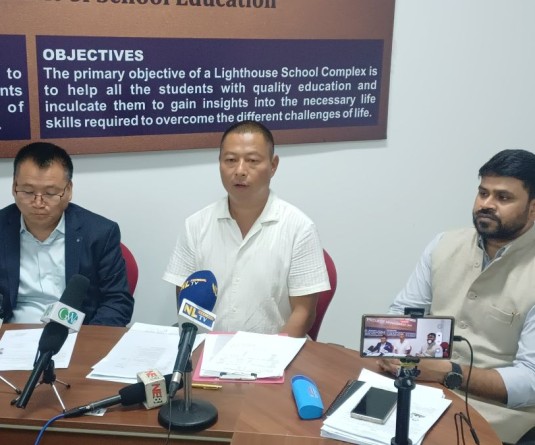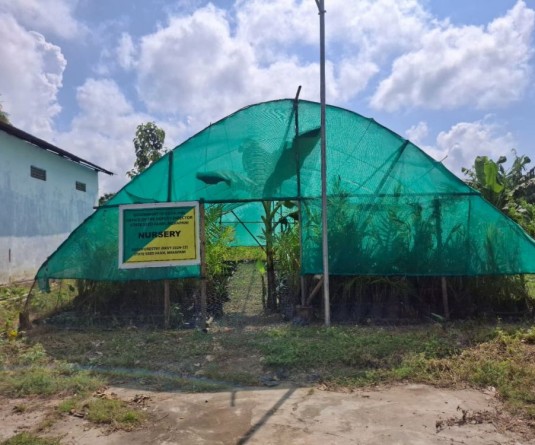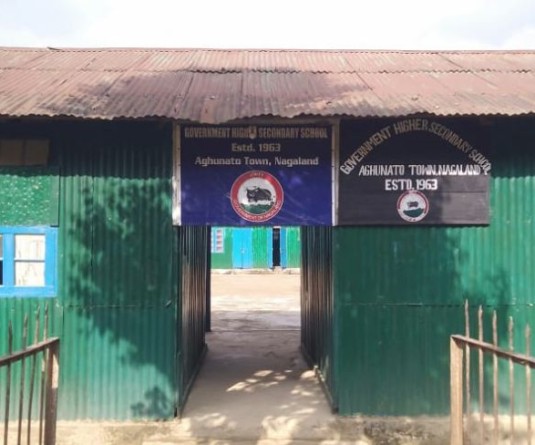Sethrongkyu Sangtam and others during the release of Survey Report on Employment, Unemployment, Skill and Migration in Nagaland 2025 on September 19 in Kohima. Morung Photo

• Employment rate in Nagaland at 83.92%, unemployment at 16.07%
• Average monthly household expenditure in Nagaland at ₹16,522
• Wokha recorded highest labour force
• Migration in Nagaland dominated by rural-to-urban moves (55%) with public sector jobs a key driver
• 24% self-employed, 13% salaried employees
Our Correpondent
Kohima | September 19
About one in six working-age people in Nagaland — 16.07% — are unemployed even as the state records an employment rate of 83.92%, according to a government survey released today. The findings highlight persistent skills shortages, uneven household incomes and migration patterns that continue to reshape the northeastern Indian state.
The “Survey Report on Employment, Unemployment, Skill and Migration in Nagaland 2025,” produced by the Directorate of Economics & Statistics, covered 4,395 households — 1,315 in urban areas and 3,080 in rural areas — and included samples from newly created districts Shamator, Niuland, Chumoukedima, Tseminyu and Meluri within the existing district framework. The study set out to determine the state of human resource utilisation by measuring skill, employment and unemployment, evaluating determinants using regression analysis and assessing migration flows.
Presenting the report in Kohima, H. Sethrongkyu Sangtam, adviser for Economics & Statistics, Information Technology & Communication and Evaluation, said he hoped it would “serve the state government to come up with good policy to tackle the problem of unemployment in the state.” He added that “the state government under the leadership of Chief Minister Dr. Neiphiu Rio was taking measures in all aspects of the state's economy, including strengthening the state data to guide policy making in the state.”
Akunu S. Meyase, secretary of Economics & Statistics, said the document would “be of utility to policy practitioners, scholars, administration and other stakeholders.” Director Neidilhou Keditsu underscored that the survey was designed to produce a quantitative picture of employment, unemployment and skills, as well as to identify reasons behind labour force trends and migration.
The survey reported average monthly household expenditure at ₹16,522, with spending ranging from as little as ₹1,133 to as much as ₹ 3,61,647. Dimapur recorded the highest mean monthly household expenditure at ₹ 22,716, followed by Kohima at ₹18,549, while Longleng was lowest at ₹13,849 — figures the report said demonstrate “the wide gap in the income disparity in the state.”
Educational attainment remains uneven. Twenty-six percent of respondents studied up to secondary school, 21% up to middle school and 2% were illiterate. Ninety-two percent of residents lack any technical education or training, pointing to “an acute deficiency in the skilling of the people to get employed,” the report said. It added that “the state requires more training institutes from both private and Government to provide skilling in Nagaland.” Only 24% of respondents were registered with the public employment exchange. The working-age household member of the family is usually counted from 15 to 59 years.
The state’s labour force participation rate (LFPR) was estimated at 56%. Wokha recorded the highest LFPR at 75%, followed by Peren at 68% and Tuensang the lowest at 41%. Mon district had the highest employment rate at 91.08%, followed by Longleng at 90.48% and Wokha at 89.35%, while Phek recorded the lowest at 75%. Phek also had the highest unemployment at 25%, followed by Dimapur at 21.57% and Peren at 19.11%. Mon had the lowest unemployment at 8.92%. Self-employment was highest in Zunheboto at 40%, followed by Wokha at 35% and Peren at 34%, and lowest in Dimapur and Tuensang at 14% each.
Migration patterns also emerged clearly. Fifty-five percent of migrant respondents moved from rural to urban areas, 25% rural to rural, 17% urban to urban and only 3% urban to rural. Main reasons cited were unspecified “others” at 35%, employment in the public sector at 27%, business establishment at 13%, marriage at 13%, employment in the private sector at 7% and education at 5%. The survey said 80% of migrant respondents earned ₹10,000 or less at their place of origin, while in new settlements 33% earned between ₹10,000 and ₹20,000.
Overall, 24% of respondents reported being self-employed, 13% were salaried employees in the public and private sectors and 9% were casual wage labourers. The report described Nagaland’s 16.07% unemployment rate — about one in six people — as high given the state’s literacy rate. Most unemployed respondents cited unspecified “others” as the reason for joblessness at 59%; none cited “shutdown of production unit” or “no financial need to work.” “These two factors is rather very interesting, the reason, may be due to nonexistent of industry in Nagaland and the other may be too much dependency on others. Notably, 8% of the respondents reported 'absence of employment opportunities in the area as a reason for unemployment,” the findings stated.
The report also noted that 65% of respondents with jobs had no written job contracts and 15% did not know their social security benefits.






